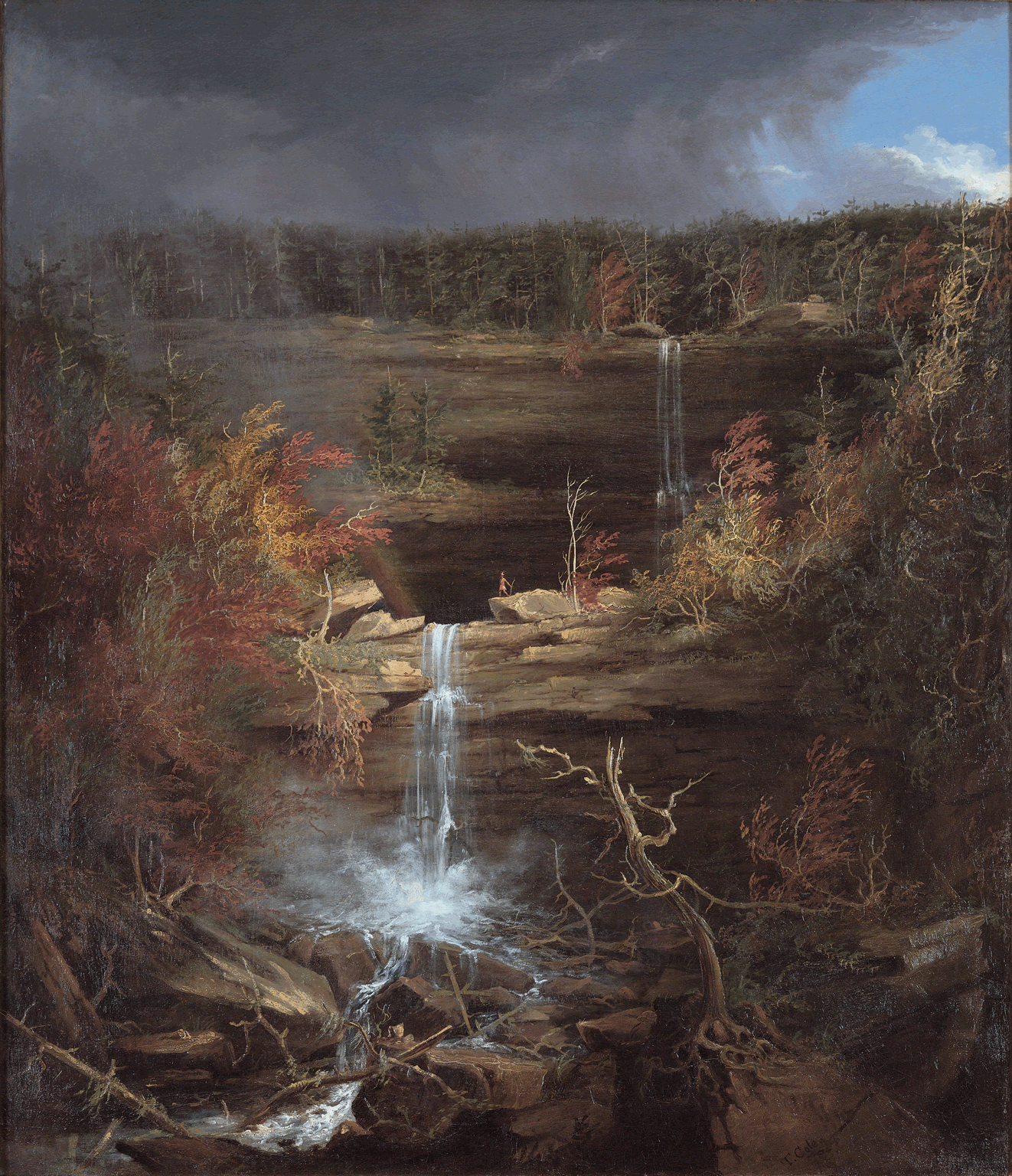Falls of the Kaaterskill

Thomas Cole, Falls of the Kaaterskill, 1826, oil on canvas, Private Collection
About
Decode
Compare
Cole's Process
Cole's Words
Locate
New York City merchant William Gracie commissioned Falls of the Kaaterskill upon the immediate success of Cole's first three paintings of the Catskill region, completed after the artist's initial trip up the Hudson in 1825.
Cole journeyed first to West Point and Cold Spring before continuing north to Buttermilk Falls, Troy, and Cohoes Falls near Albany, where the Hudson and Mohawk Rivers meet. On the return trip, Cole spent extended time in Catskill, stopping at the Catskill Mountain House. 1
The artist spent the following winter on the Schoharie River estate of George William Featherstonhaugh, where he worked tirelessly on the many commissions he had received that year.
Cole was not the first artist to venture into this region. The Irish-born landscapist William Guy Wallpublished a series of picturesque views in the Hudson River Portfolio(1821-26), engraved by John Hill.
In fact, the Catskill Mountains region was fast becoming a popular tourist destination as wealthy Americans began to look to their own native countryside for recreation and aesthetic inspiration. The Catskill Mountain House, built in 1824 on an escarpment overlooking the Hudson Valley, offered accommodations for such guests, and carriage roads were built in order to make remote mountain areas more accessible to tourists.
Kaaterskill Falls, first introduced to the American public through such publications as James Fenimore Cooper's The Pioneers (1823), was a major destination for tourists at the time.
Cole frequently composed poetry and essays about the beauty of Kaaterskill Falls. In 1843, he wrote:
There is a deep gorge in the midst of the loftiest Catskills, which, at its upper end, is terminated by a mighty wall of rock; as the spectator approaches from below, he sees its craggy and impending front rising to the height of three hundred feet. The huge rampart is semi-circular. From the centre of the more distant or central part of the semi-circle, like a gush of living light from Heaven, the cataract leaps, and foaming into feathery spray, descends into a rocky basin one hundred and eight feet below; thence the water flows over a platform forty or fifty feet, and precipitates itself over another rock eighty feet in height; then struggling and foaming through the shattered fragments of the mountains, and shadowed by fantastic trees, it plunges into the gloomy depths of the valley below. 2
Mouse over the detail to view its caption, click it to zoom in, and use the reset button on the lower right to zoom back out.
1. Cole often attempted to evoke emotion through his depictions of the sky, which he called "the soul of all scenery." Here, he introduced storm clouds to create drama and suspense and to heighten the awe of viewing the Falls.
2. Consisting of two separate cataracts, Kaaterskill Falls is one of the highest waterfalls in New York State. Cole painted at least three other versions of the site.
3. The Native American in Cole's work symbolizes wild, unspoiled nature, even though indigenous people had left that part of the state long before. The smallness of the human figure in relation to the landscape emphasizes humankind's fragile vulnerability.
4. Like his wealthy patrons, Cole studied geology and kept his own collection of minerals, fossils, and rocks. He paid particular attention to the rock formations at Kaaterskill Falls, noting geological features in his sketchbook.
William H. Bartlett, The Caaterskill Falls from Below, engraving, c. 1830, 4 ½ x 7 in. Engraving by E. Benjamin. Published in American Scenery, or Land, Lake, and River Illustrations of Transatlantic Nature (1840), McKinney Library, Albany Institute of History and Art. View in Scrapbook
Bartlett painted views of popular tourist destinations in the United States. Engraved reproductions of his work were published in American Scenery, the most influential nineteenth-century volume of landscape views in the United States. In his idealized depiction of the plunging cataract, Bartlett drew from Cole's famous Falls of the Kaaterskill, also eliminating the observation platform. But he chose to exaggerate the height of the waterfall and replace the human figure with birds. Bartlett'simages, made widely available through reproductions, helped to promote tourism in the Catskill area. 1
Process
By 1825, Cole's creative process involved forming what he called his "mind's eye vision" of the sites he had visited. He would call upon his sense of how things should look as well as relying on the drawings he had made in the field. His on-site sketches were often laden with notes describing color, atmospheric effects, and specific geological formations. He orchestrated these sources into strikingly inventive and idealized conceptions.
In Falls of the Kaaterskill, he exploited the pictorial possibilities of this wild and spectacular site. Here, Cole was in his element, reveling in the sort of landscape that inspired him most: grand, impressive, jagged, and sublime. Cole recorded his visual impressions in the en plein air study Catskill Falls, executing a rough topographical pencil sketch with notes describing the Falls' various trees, shrubs, and rock formations. He also made quick note of the observation pavilion and guard rails at the top of the cataract, which had recently been installed to accommodate tourists flocking to the site from the nearby Mountain House.
In the studio, Cole developed a charcoal-and-crayon sketch entitled Double Waterfall—Kaaterskill Fallsthat still bears the imprint of his observations at the site (note that the observation pavilion and guard rails remain). Although charcoal drawings such as Double Waterfall are among Cole's most lovely works on paper, he rarely used this medium, preferring to work in graphite.
Writing to his patron, Robert Gilmor, Jr., Cole described his process:
In speaking of sketching from nature I believe I have before mentioned that mine are generally mere outlines & I have found that for me the mode I have adopted is the best—others may pursue a different course to advantage. My desire & endeavor is always to get the objects of nature, sky, rocks, trees, &c—as strongly impressed on my mind as possible & by looking intently on an object for twenty minutes I can go to my room & paint it with much more truth, than I could if I employed several hours on the spot. 1
From the charcoal drawing, Cole composed a small, preliminary oil sketch, Kauterskill Falls, in order to refine his ideas about color and composition. Finally, he arrived at his much more dramatic full-scale painting, based on all these preliminary works. Although Cole visited the site before the leaves had turned, Falls of the Kaaterskilldisplays the full blaze of autumn foliage. To further emphasize the Falls' wild and primitive quality, he dispensed with signs of tourism, such as the platform and railings, and instead inserted a solitary Native American perched on the rock ledge. The final work provides a much more exciting vision of the American wilderness than those provided by Wall's earlier views of the Hudson River Valley.
Works
1. Thomas Cole, Catskill Falls (Kaaterskill Falls), pencil on paper, c.1825-26. Detroit Institute of Arts. Founders Society Purchase, William H. Murphy Fund, 39.206.A.View in Virtual Gallery
2. Thomas Cole, Double Waterfall--Kaaterskill Falls, graphite pencil, charcoal, black and white crayon on off-white wove paper, 1826. Detroit Institute of Arts. Founders Society Purchase, William H. Murphy Fund, 39.503. View in Virtual Gallery
3. Thomas Cole, Kaaterskill Falls, oil on canvas, 1826, 9 ¾ x 7 ¾ in. Graham Williford Foundation for American Art. View in Virtual Gallery
4. Thomas Cole, Falls of the Kaaterskill, oil on canvas, 1826, 43 x 36 in. The Westervelt-Warner Museum of American Art in Tuscaloosa, AL.
Words
And now I must turn to another of the beautifiers of the earth—the Waterfall; which in the same object at once presents to the mind the beautiful, but apparently incongruous idea, of fixedness and motion—a single existence in which we perceive unceasing change and everlasting duration. The waterfall may be called the voice of the landscape, for, unlike the rocks and woods which utter sounds as the passive instruments played on by the elements, the waterfall strikes its own chords, and rock and mountains re-echo in rich unison. And this is a land abounding in cataracts; in these Northern States where shall we turn and not find them? Have we not Kaaterskill, Trenton, the Flume, the Genesee, stupendous Niagara, and a hundred others, named and nameless ones, whose exceeding beauty must be acknowledged when the hand of taste shall point them out? 1
"The Falls of the Caterskill in Winter"
Winter, hoary, stern and strong,
Sits the mountain crags among:
On his bleak and horrid throne,
Drift on drift the snow is piled
Into forms grotesque and wild:
Ice-ribbed precipices shed
Cold light round his grisly head:
Clouds athwart his brows are bound
Ever whirling round and round.2
Find it here.
